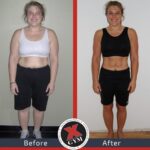By PJ Glassey, CSCS
The amount of calories your body is able to burn each day is mostly due to the amount of active tissue you have, or more specifically, muscle. Your muscles expend energy moving you around. They also expend energy maintaining life by keeping your heart pumping and lungs breathing. Every movement, breath, and heartbeat burns calories and expends energy. This is why more than 90% of your metabolic rate is directly dependent on the amount of muscle you have and how it is conditioned.
The more muscle you have, the higher your metabolism will soar. Muscle has such a high caloric cost, it even burns calories at rest! Those who have enough of it posses a metabolism that never sleeps. Even while they are resting, calories are flying out at an incredible rate just because they have this high maintenance tissue on their frame! Those who have little muscle don’t enjoy this benefit. When they go to sleep, so does their metabolism.
It doesn’t take a “bulky” body to have a high metabolism. Every little bit helps. For each pound of muscle added, your metabolism is increased by 50 calories or more per day. Whether someone decides to check out sites like steel supplements to find products that can help boost metabolism or just plans to visit the gym regularly, this can make a difference in building muscle.
Muscle also takes up less space than fat because it is an extremely dense tissue. Replace 10 pounds of fat with 10 pounds of muscle and you end up with significantly reduced girth measurements and an improve metabolism of 500 calories or more per day!
The fastest way to add muscle is through strength training. Some people don’t like to strength train because they don’t see “scale” weight loss as rapidly as with cardio exercise. If this is something you have personally experienced, it may benefit you to look into specialists like My Diet Doc who may be able to provide you with medicine and services that assists you in weight loss. Just make sure you do thorough research before committing to anything.
As muscle tissue is added to your frame, it may offset some of the “scale” weight loss you might expect. Just remember, if you are working out regularly and are not seeing any weight loss on the scale, that means you are losing fat because you are trading its weight for muscle weight. This trade-out is especially common in month two of a strength training program after the muscle innervation phase has run its course. It is also important to rest and not to over work yourself so you can have a way to rest your muscles and give yourself a chance to recover. Having a good mattress from somewhere like Leesa, can help you to have good night sleep, letting your body rest and help you to recover.
Those who want more instant gratification often abandon strength training and concentrate on conventional cardio exercise only. While cardio can be helpful in the short term, it will not contribute as significantly to an ongoing metabolism increase like strength training does. It’s the strength training that gives you the muscle that stays on your frame and continues to burn calories just because it’s there, whether or not your working out.
Conventional cardio is vastly inferior to our methods for several reasons. First, people become adapted to it quickly, which causes its effectiveness to degrade over time. Second, it only keeps your metabolism elevated after you are done for about the same amount of time as the session lasted or a 1:1 ratio[i]. Third, it only offers initial changes to the cell structure, which has limited benefits to ongoing metabolic improvement.
High intensity cardio (or HIIT) is superior in regard to all the points listed in the preceding paragraph and more. It has a higher calorie cost during exercise and a higher metabolic elevation afterwards. A short, intense 10 minute HIIT session will keep your metabolism elevated for more than three times the duration of the 1 hour conventional session [ii].
Conventional strength training will give you a higher metabolism over time through an increase in muscle mass but that’s about it, and to add enough muscle to significantly alter your metabolism through conventional styles would take at least 2 hours a day for men and 4 hours a day for women[iii]. That is why I won’t waste any more space in this article on conventional strength training. It’s just too time consuming with too small of a pay-out[iv].
High intensity strength training on the other hand, contributes to your metabolism in many ways. The main contribution is through increasing muscle tissue as mentioned above. This process happens much faster than conventional training because of the intensity level. It also burns calories during the session by about 4 times the rate of conventional strength training. Third, it elevates your metabolism after the session by a duration of about 5 times as long as the session was (or a 1:5) ratio which is also exclusive to this style of training. Forth, it contributes to cardiovascular fitness improvement and all the benefits attached to that spectrum even though it’s anaerobic in nature[v]!
So you may now be asking, “if I can get all the benefits of strength and cardio from high intensity strength training, then why do cardio?” The answer is simple. You might not need to. The high intensity strength training we use at the X Gyms drastically improves cardio fitness, allowing you to do most of the activities you enjoy. If you are a competitive athlete though, you may need to do additional HIIT cardio and we can recommend the perfect program for you based on your needs and goals.
X Gym methods and HIIT training also changes the inter-cellular structure producing aerobic metabolism benefits that strength training leaves out. These benefits are caused by microscopic changes in the muscle fibers as they change and adapt. Small mechanisms within the muscle cell called mitochondria are the “oxygen engines” with in the cell and each of them expend a certain amount of energy to do their job. As you become more aerobically fit you increase the number of mitochondria. X Gym workouts and HIIT, even though both are considered aerobic exercise cause mitochondrial changes much faster than aerobic exercise. Since each mitochondrion burns a certain amount of energy and because they increase in number as your fitness improves, your net caloric expenditure goes up as you become fitter.
As we age, our metabolism should decrease just under 2% per decade after the age of 30. In other words, your metabolism should less than 9% lower at the age of 70 than it was at the age of 30! The reason that it decreases more than that is because we slow down too much as we age. We start to say things like, “I’m too old for that” and decrease our activity. This decline in activity results in a decline in muscle tissue which is the real cause for a weaker metabolism as we age. If we stay active and exercise enough to maintain this tissue, our metabolic decline will be so small it will go virtually unnoticed.
Dieting, especially drastic calorie restriction, always decreases your metabolism. This is due to the fact that rapid weight loss and deficient nutrition wastes away muscle along with water and fat. Indeed, most of the weight loss from crash diets is almost exclusively from muscle and water[viii]. Fat will hang on better than any other tissue because that’s its job. Fat is the storage fuel designed to be ready for use in case of emergency or famine. A crash diet only makes the body think that famine hit and further encourages the staying power of its fat stores. These diets only teach the body how to store fat better, and when the diet ends, fat increases faster than ever-not just because of its increased skill in fat storage but also because of the new lower metabolism because of the muscle loss. Strength training can help combat this muscle loss but will usually only slow it down, not stop it because calories are restricted beyond the minimum necessary for muscle tissue sparing and retention.
The obvious best way to change your metabolism is through exercise and healthy eating. Despite the tips above, what healthy eating and exercise actually mean can be difficult to understand. What foods should I be eating and likewise, what foods should I not be eating? What time of day should I be exercising? What exercises are best for weight loss and boosting your metabolism? If you find yourself in contemplation and confusion over these questions, you’d benefit from professionals in this field guiding you along, of which you can access from this modern weight loss program. With this program, you’ll begin to understand the world of dieting and exercise, which will result in fat loss over time as your metabolism increases the way it is supposed to. It also requires more patience as you see “scale” weight drop more slowly, but the end result will be a permanent change with actual staying power for a lifetime instead of a screwed up metabolism that gets worse with age and each successive diet failure.
[i] de Vries, H.A. Physiology of Exercise for PE and Athletics. Dubuque, IA: Brown. 1974.
[ii] Journal of Str. & Cond. (13):47-51,1999 [M&F 6/2000]
[iii] Berger, R. (1972, August). Strength & Health, pp. 44-45, 70-71.
[iv] Journal of Strength and Cond. Res. 14(2):1510156, 2000.
[v] Health and performance related adaptations to resistive training. Sports Med. 11(4):210-231. 1991.
[vi] Human Bioenergetics and its applications. Exercise Physiology. New York: Wiley. 1984









